All-New Compact Crossover Utility Vehicle
With the second decade of the 21st Century coming to a close, there is nothing hotter in the automotive world than the crossover utility vehicle or CUV. If a manufacturer doesn’t have at least one, lay a bet they will soon. One company that has a few that are consistently rated among the best is Mazda. Its CX-3, CX-5, and CX-9 all fill a need with style, comfort and performance. Beginning in mid-December 2019 (i.e., now!), the all-new 2020 Mazda CX-30 will be in dealerships, offering consumers a five-seat compact crossover that will immediately climb to the top of the best-in-class list.

Mazda brought automotive media to San Diego in early December, where designers, engineers and marketing staff gave us a deep dive on the CX-30. After a nearly two-hour technical briefing, we were handed the keys to a CX-30 and set free to drive from the Pacific Ocean to Palm Desert. What made the drive over the Cuyamaca Range extra interesting was that it was in a driving rainstorm. With snow alongside the road, we hit areas of standing water, small rock slides and other challenges that gave a true feeling for the driving, handling and performance attributes of the CX-30.
Getting There
Slotted between the subcompact CX-3 and the compact CX-5, the all-new 2020 Mazda CX-30 is built off the very fun-to-drive Mazda 3 sedan and hatchback platform. If you have ever driven a Mazda you will know that, top-to-bottom, the lineup is the best handling cars and crossovers that aren’t marketed as a sport models. The CX-30 does not disappoint in handling, performance or efficiency.

The Skyactive-G 2.5-liter engine was a great choice for the CX-30. This smooth and responsive four-cylinder engine produces a class-leading 186 horsepower (hp) and 186 pounds-feet of torque (lb.-ft.). The CX-30 comes standard with front wheel drive; the i-Active all-wheel drive (AWD) is a $1,400 option. Clean Fleet Report’s CX-30 had the AWD, and were we glad it did! Our ocean-to-the desert drive needed every bit of extra traction. Regardless if it is two or four wheels driving the CX-30, the six-speed automatic transmission with paddle shifters and Sport mode was never at a loss finding or being in the right gear. This was noticeable when climbing mountains and getting on-and-off the accelerator on tight curves.
The EPA rates the CX-30 AWD at 25 city/33 highway/27 combined miles per gallon (mpg). However, in 130 miles of driving on a mountainous course I averaged 30.1 mpg. When Clean Fleet Report has the 2020 Mazda CX-30, for a week or more, we will do all-freeway runs that will most certainly surpass this mileage, possibly even getting near 40 mpg. Breaking the all-important 30 mpg mark for the average mileage could be the deciding factor if a CX-30 is parked in your driveway.
Driving Experience: On the Road
Out on the road, the CX-30 truly shows its mettle.
The engine is quiet and provides plenty of acceleration, with 0-to-60 times in the mid-seven seconds. The ride was smooth and the handling agile. The accurate steering, the G-Vectoring Control Plus system and a redesigned suspension with all-new bushings were part of what Mazda says is “a feeling of oneness.” Usually such flowery words are questioned, but not this time.

The i-Active AWD uses instantaneous driving data to anticipate wheel slippage, resulting in smooth traction in all conditions. When cornering, the G Vectoring Control Plus, unique to Mazda, adjusts engine torque to shift weight, increase steering response, and apply a bit of brake to seamlessly aid in making cornering an ease. The CX-30 isn’t supposed to handle like the Mazda MX-5 Miata, but it sure was planted and solid in anything we threw at it.
Driving Experience: Exterior
Following its “Kodo–Soul Of Motion” design language, Mazda says the CX-30 ”has the flowing beauty of a coupe and the bold proportions of an SUV.” That was fun, but how does that translate to an actual design?

Mazda has a “car as art” philosophy where terms like “handmade design,” “sleek and bold” and “interplay of light and shadow” play a major part in getting the proportions and design right. Design cues include a long hood, laid-back windshield, short overhangs front and rear, and a raked window on the power liftgate with an integrated spoiler. The narrow LED head and taillights allowed the designers to take up as little real estate as possible, and the grille does not suffer from being overly large. Opt for one of the three premium paint colors of Soul Red Metallic, Machine Gray Metallic or Snowflake White Pearl Mica, and the CX-30 becomes all it can be.
The 2020 CX-30 has by far the most refined elements of Kodo, resulting in a beautiful crossover.
Driving Experience: Interior
At first impression, the up-market interior on the CX-30 Premium looks like a class above. The subtle two-tone color scheme with aluminum accents was pleasing to the eye. Cloth is standard, but on the Premium trim level the leatherette seats were firm and comfortable. The tilt and telescopic heated steering wheel with cruise and audio controls made a comfortable driver seating position easy to find.

Up front, the logical dash layout is simple and clean. The three round gauges with black faces and white letters were easy to read with the round automatic HVAC knobs conveniently placed above the center console.
The 8.0-inch color display (not a touchscreen) erupts from the dashboard and is home to the Bose premium audio system. With 12 speakers, the sound quality is excellent for the AM/FM/CD/MP3/AUX HD radio, SiriusXM, Pandora, Apple CarPlay and Android Auto. The Mazda Connect connectivity system includes navigation and Bluetooth. The head-up display was a pleasant surprise; a safety feature Clean Fleet Report believes should be standard on all cars.
Mazda’s audio system interface has been reworked so you are no more than five steps from accomplishing any goal. Mazda admitted that, for a journalist only being in the car a few hours, it may not be enough time get the hang of operating the system. We were assured though that owners get it–and like it. We found the operation to be cumbersome to make channel and memory changes. It required multiple steps to control a single function, and the need to use the center console-mounted selector knob diverted the driver’s eyes from the road. As Mazda said, in time it may become an easy operation that can all be done by touch, but there are many simpler systems Clean Fleet Report has used. With the excellence of the Mazda line-up, its engineers could easily design a more user-friendly interface.
Observations: 2020 Mazda CX-30
Mazda was very clear that the all-new 2020 CX-30 was “right-sized” for couples, singles and families with small children. We agree on the first two, as with the rear seat laid flat the carrying capacity is excellent for long, fuel-efficient road trips. For a small family, the CX-30 will be an entry vehicle, leading to stepping-up to a CX-5 or CX-9. In other words, Mazda has you covered as your family grows.

The cabin, upfront, is spacious, with the rear seat capable of carrying three adults. The storage capacity, 20.2-cubic-inches with the rear seat upright, is plenty large enough for two, but would be a tight squeeze for all the gear necessary for four. The retuned suspension delivers a smoother and quieter ride than is expected in a compact crossover. Not enough can be said about this superb handling vehicle, especially with the i-Active AWD system.
With dealers taking deliveries before the end of December 2019, expect pricing to range from $21,900 to $29,600, plus options. Prices shown do not include the $1,045 destination and handling fee.
This is a very fine vehicle, and one that should be at the top of your shopping list.
Make sure to opt-in to the Clean Fleet Report newsletter (top right of page) to be notified of all new stories and vehicle reviews. This includes a deeper look at the 2020 Mazda MX-30 after we have had the chance to drive it for a week or more.
Whatever you buy, Happy Driving!

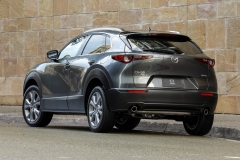
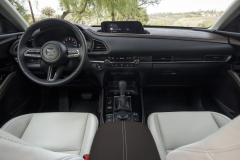
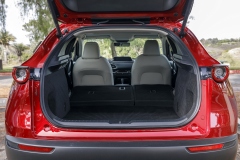
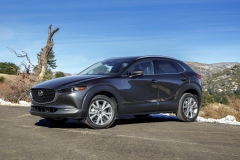
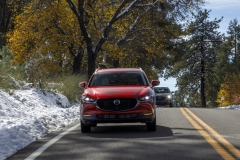
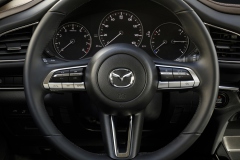
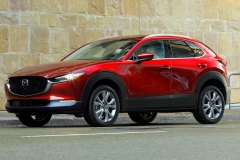
11 thoughts on “Flash Drive: 2020 Mazda CX-30”